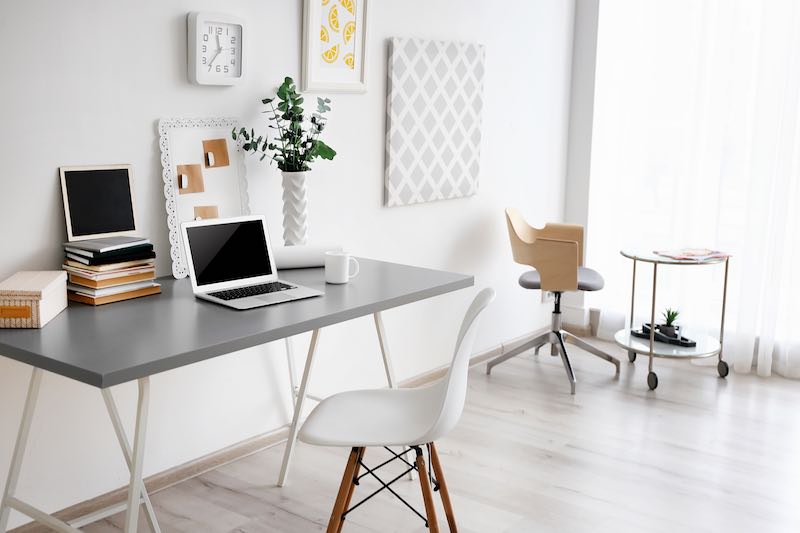
10 Ways To Declutter, Simplify & Increase Office Productivity
Table of Contents
Is there any connection between office minimalism and office productivity? This is a question we’re about to answer in this article.
I am sure you know someone who is perpetually late, loses their car keys, is never quite ready for the meeting, and basically stumbles through the workday.
That kind of chaos stems from a lack of organization and not having a minimalist office.
Essential papers get lost underneath the daily deluge, and projects are not done on a timely basis because they can’t find the bits and pieces they were trying to put together.
But you are smarter than that! You recognize that chaos is lurking just outside the door.
You also know that a lack of office productivity eats up time and can swallow your enthusiasm when clutter derails your effort
Our List of 10 Ways To Declutter and Simplify
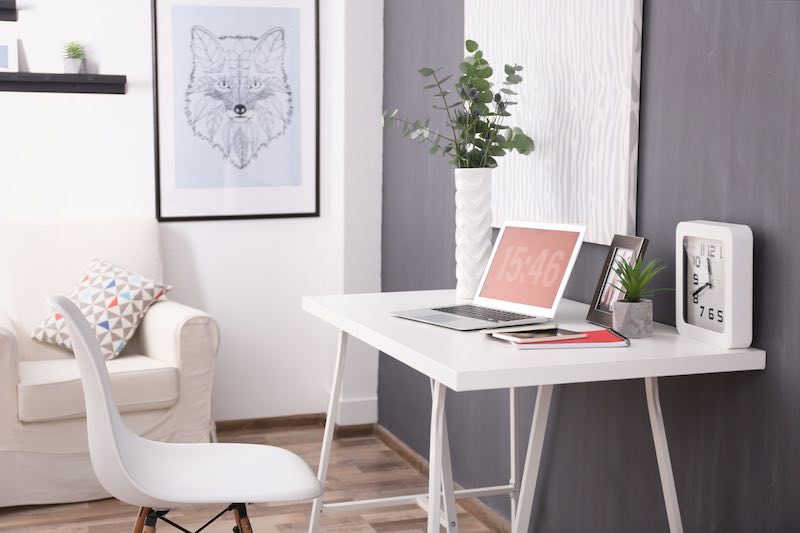
#1 Make a Start – Declutter
One way to start on your journey to a minimalist office is to get a box and put all of the clutter on your desk (not paperwork) into the box.
As you go through the day, week, and month, take out an item when you use it and decide on a place on your desk for them.
At the end of a month, if you have not used the items remaining in the box, give them away or dispose of them so that what remains on your desk is minimal.
We have put together a list of action items to help create a minimalist office that will increase your office productivity.
#2 Put items in their place
Decide on a home for your phone, your stapler, and any other implements that you use daily.
Keep those items in their designated spots so that you can find them when they are needed.
Looking for something you need is such a time waster and can derail you quickly.
Determine what will make your desk more functional. There are risers available for your monitor that have room to store items underneath.
Consider a monitor arm that raises your monitor off the desk and provides more desk surface space.

#3 Keep Only what You need in Arms Reach
Put anything not required away. The books go back on the shelf, the stapler back in its spot, and the extra pens in the drawer.
The clutter of extra papers, a manual here and there and files everywhere slow you down and puts a halt on productivity.
#4 Take Time to Create Files
If your particular job requires a paper trail or hard copies of contracts, set up a file system to handle those papers.
Your work should provide for the necessary office supplies to organize your paperwork. Hanging file folder, labels, post its, file dividers, and even a file cabinet if it is needed.
Set your files up with relevant folders and use an alphanumeric system. Important papers will not end up lost in the shuffle, and yet they will also not pile up on your desk.
#5 Streamline the Paper
If you feel you need to keep that piece of paper, then file it. If you need to keep certain documents close at hand, ask for a document tray that sits on your desk.
Stacking trays can have numerous levels to keep essential papers organized and easy to find.
Decide if you need a hard copy. If possible, scan it digitally and create a desktop file system.
If you can find the information online, you probably don’t need to keep a hard copy of manuals for printers or scanners.
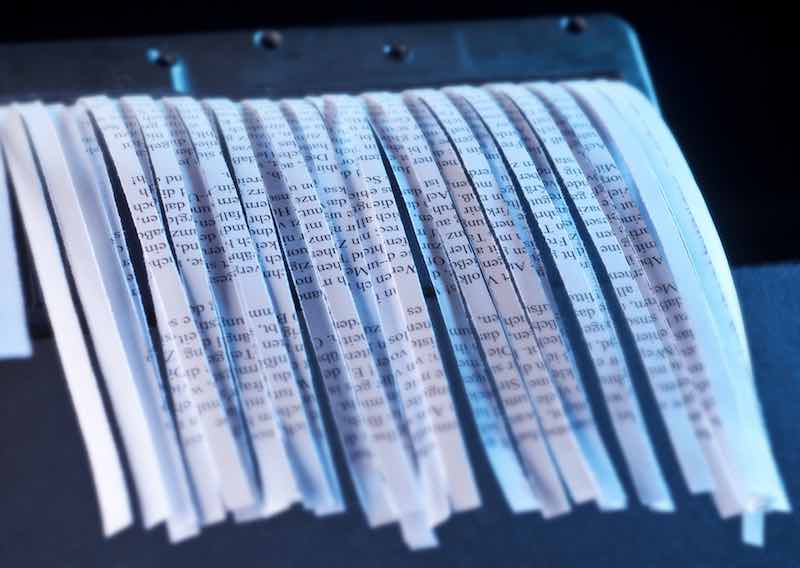
#6 Shred-it
If you don’t need it, don’t keep it around. Have a shredder handy or use your office’s recycling bins.
It seems like it takes double the time to go back through a stack of papers to decide if it is needed or not, then if you had made a choice the first time around.
If it is sensitive or has names, addresses, or has a bank or personal information, shred it once the data is no longer needed.
Keeping sensitive documents past their use-by dates can compromise a client’s accounts and information.
Lack of organization could put someone else’s information at risk and jeopardize your employment.
#7 Reevaluate
Maybe you have an item that is necessary but used only periodically, like a laminator. You need it, but not every day.
See about rehousing it in a storage closet so that it is not contributing to the disarray and lack of workspace.
Consider carefully if you really need it, or just think that you might need it. Is there an easier way to get the job done without a lot of equipment.
If you do need it, find a spot that it can reside until you need it rather than having it take up your creative space
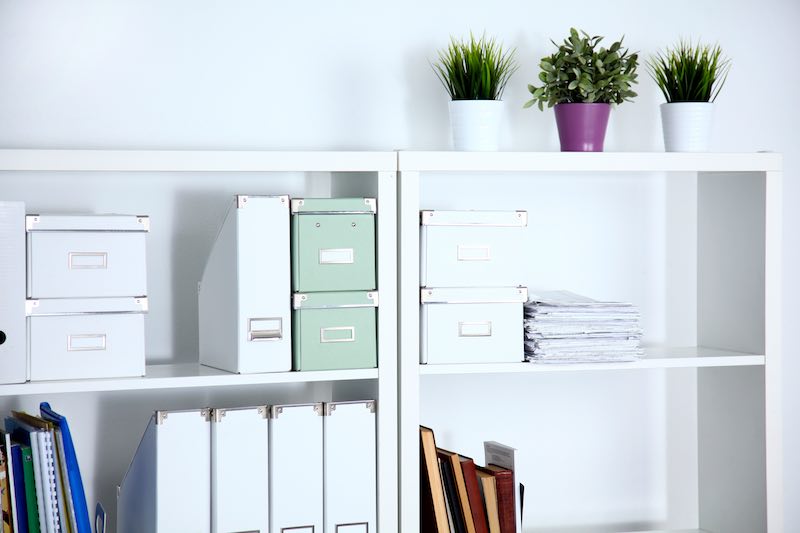
#8 Use Vertical Storage
An office supply store, or an online supply store, has items for every type of organization issue you might face. Some of them are pretty clever.
If you have a cubical, there are vertical hanging files that keep paper in reach but off of flat surfaces that get cluttered in a hurry.
The file folders can also hang off a door, and there are rolling files that can slide under your desk when not needed.
Overhead bins store a lot of items that are necessary but take up precious real estate.
Some overhead bins have doors that close and keep all of those odds and ends out of sight, reducing the amount of visual stimulation that comes with a mountain of items.
If you store items in boxes, label those boxes, it will save you time and keep you from having to look in each box for the desired object.
You will be able to see at a glance where things are stored.
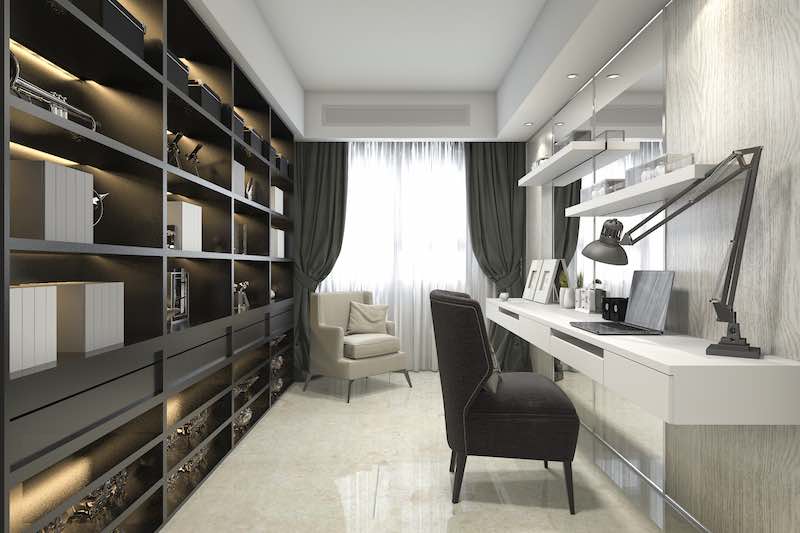
#9 Go with the Flow
It would be counterproductive to have a printer on one side of your workspace and copy paper on the other side.
Take a few minutes to think about what your job requires and how that would be best orchestrated.
Set up your supplies so that your movement flows rather than them being cumbersome and awkward.
You also don’t want to be halted in your tracks by not having the supplies you need. That would mess with the flow.
Depending on how supplies are handled in your office setting, keep a supply of the essentials at the ready in a storage area.
Lack of printer ink, copy paper, or other critical supplies can halt progress in a hurry.
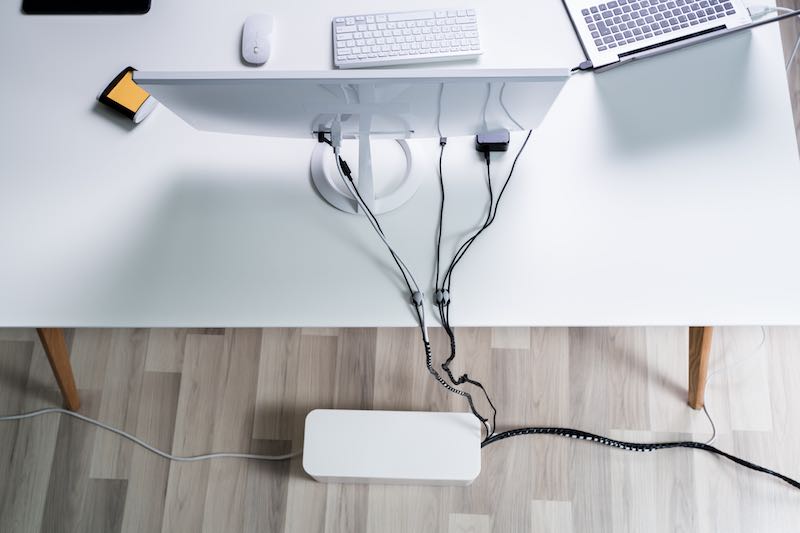
#10 Tame the Cables
Whenever possible, go wireless. Even one or two fewer cables will make a difference in lessening the tangle.
You can also get casings for your cables that bundle them together and provide a less haphazard arrangement of wires.
Here are some additional thoughts on simplifying, decluttering and increasing office productivity.
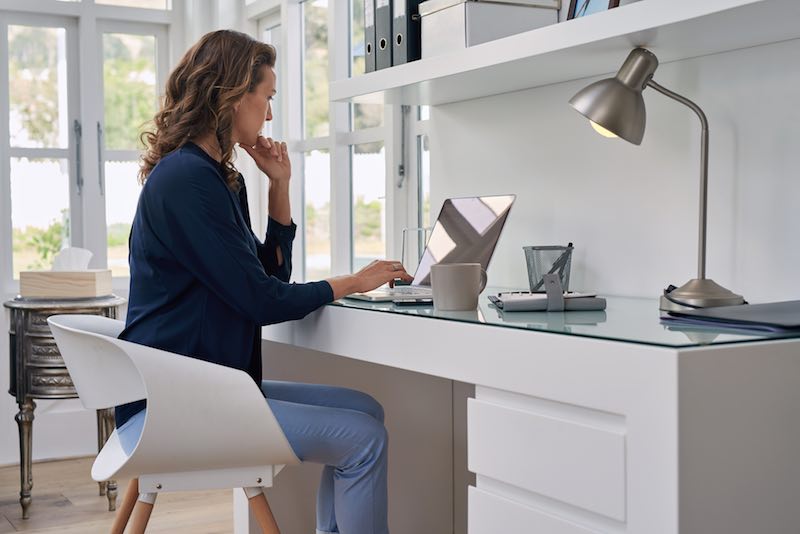
Make it a Daily Habit
Before you leave for the day, get in the habit of taking a few minutes to straighten your work area.
It is discouraging to arrive for the day’s work and be greeted by disarray and remnants of yesterday’s workload.
Give yourself a fresh start and the encouragement that comes with an organized desk and a minimalist office.
It is no mistake that the general opinion is that a cluttered desk goes along with being less than competent. If you can’t manage your clutter, how can you be perceived as in control?
The few minutes spent will pay dividends when you come into start a new day with all of your tools in place and no delays in starting on the day’s projects.
Here are some other tips on 9 Ways to Create Minimalism In Your Office Decor.

A Way of Life
Minimalism is a way of living that is advantageous in an office setting. It is not so much getting rid of the excess as it is thoughtfully choosing the items that you allow in your space.
An offshoot of this thoughtful acquisition of only the necessary is the eventual effect of having less paraphernalia.
Maintaining a minimalist space is not about having less; it is about having only what is important.
Another important byproduct of the minimalist way of thinking is that you will automatically reassess what your priorities are.
You will begin to eliminate things that don’t bring value to the table and only let in what is important.
When you begin to eliminate the extraneous, there is more time to focus on fewer things, and that is the key to productivity.
We interact with every object in our environment, and it stimulates our minds. We can’t help it. That’s how our brains work.
That is why it’s hard to focus when we’re continually distracted by the things around us.
Having a minimalist office is not a new concept. The idea that less is more has been around for a long time.
There have been some intelligent people, like Socrates, Albert Einstein, and Steve Jobs, who brought the same philosophy to their work and saw success with that application.
What minimalism in the workplace achieved for them was the ability to focus and cut down on distractions.
This video will delve more into Steve Jobs Minimalist philosophy.
You may have many tasks in your workday, but end up doing those that are relatively easy and quick to foster a sense of accomplishment and leave the more difficult for later.
When you seek to use minimalist office principles applied to goals and time commitments, you can free up time to do the tasks that matter in your job.
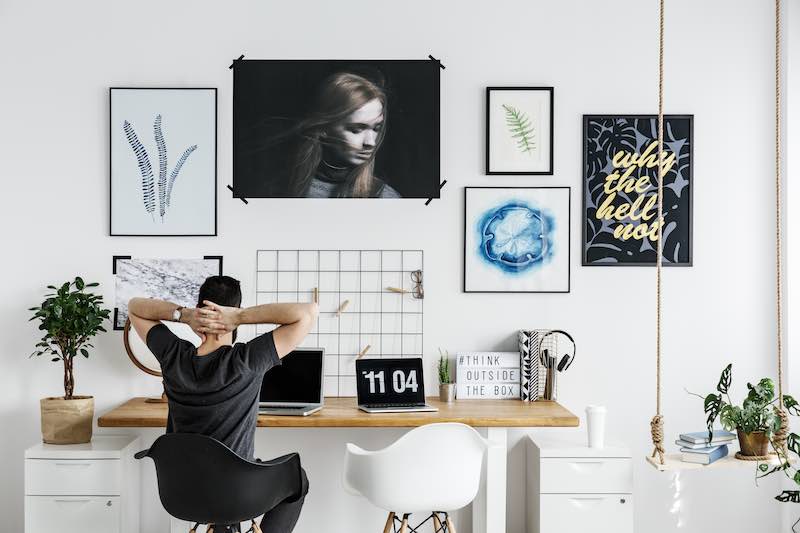
Know the Goal
As we mentioned before, always start with a clean workspace. You really can’t do office work if you have no space to do it in, and there is no sense of order to the mess.
While I always had a to-do list and prioritized it each day, I often left the workplace feeling that I had not accomplished much and being disheartened.
When I learned to minimize the list and focus on what was eminent, I found that I accomplished more and left work feeling encouraged.
Know what the goal is. Determine the goal of the day before you begin working.
Give yourself the top three, maybe four, tasks for the day and focus on those tasks. You will find that as you are able to clear the major items, the smaller tasks will follow suit.
Learn to distinguish the most important task from the ones that are not as important. Ask yourself: “will this activity move me towards the goal?.”
If it does not, then take it off of the list.

Silence the Voice
While you might find writing down your few tasks for the day, you may still carry around a mental list of less critical tasks.
That mental list may raise its head and clamor for your attention and be a distraction. If you find that this is the case for you, try this exercise to see if it helps calm that mental noise.
Take about 15 or 20 minutes to create a word document of all the other tasks, thoughts, or projects that are demanding attention in our mind.
Once you have made a record of these other items, close out the document having confidence that you will not forget these items. This exercise should be able to stop those thoughts from demanding your attention and derailing your focus.
As you consider how a minimalist office space will contribute to you being more productive, also ask yourself these questions:
- What tasks yield the most results?
- What interruptions derail my productivity?
- What tasks can I delegate or eliminate?
- What tasks can I automate?
By answering the questions above, you will be able to free up your time and be able to focus.
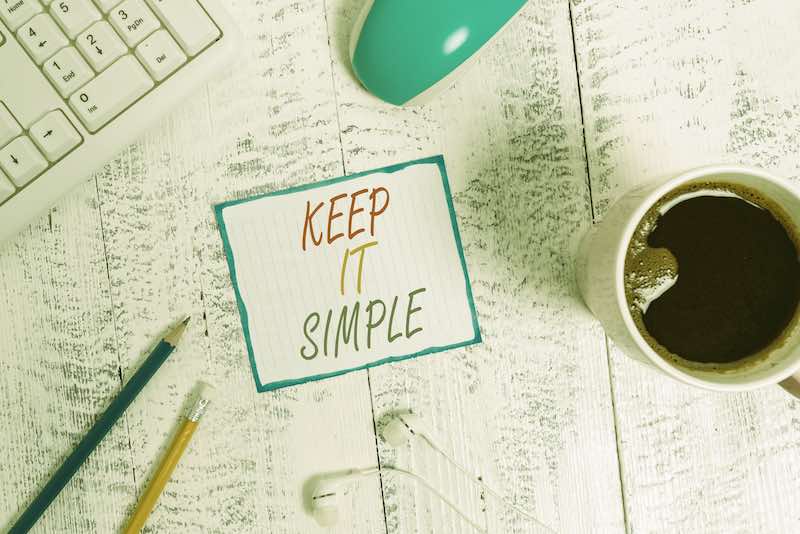
No. Plain and Simple. No.
You may need to learn to say no. There is a saying, “while you can do anything, you can’t do everything.” If you are asked to take on a task that does not advance the goal assigned to you, it would be best to decline.
Believe me, I understand the “team player” mentality and agree with it when circumstances call for all hands on deck.
However, some will attempt to draw you into meetings and projects that are not your responsibility.
Part of office productivity and the minimalist style is to know when to decline a request.
Be polite but firm, and if you know the answer upfront, give it quickly so that there is no doubt or hesitation.
It is not that you can’t; you don’t have the extra time or talents to expend. Help when you are able, but not at the expense of your tasks.

The Myth of Multitasking
Here is yet another adage to think about: “jack of all trades and master of none.” There is much truth in that saying.
Multitasking is not all that it is cracked up to be. Going from one task to another and back the first may seem as if you are accomplishing things, but backtracking and redirecting inhibit focus.
In some cases, it has been shown that multitasking can reduce productivity by as much as 40%.
Allot time to focus on one task and one task only. Make it an email-free time, and resist the temptation to check your inbox.
This might sound counterintuitive but take a break. Don’t work through lunch or take work home.
You need time to recharge your mental batteries and to decompress. We talked about the way our brains worked earlier in this article.
Our brain also needs a moment to itself. Your ability to stay focused and engaged is significantly compromised when you do not give it a needed break.
It does not have to be a long break, even a five-minute walk down the hall every 60 or 90 minutes is all that you need.
Get out of your chair and stretch. Listen to a favorite song, or look out the window to see what is going on in the world.
Just give your mind a brief break, and you will find that your ability to concentrate will be better for it.
In Conclusion
We live in a fast-paced and ever-changing world. But life is what you make of it. If you choose to make yours more minimal, you might be surprised to find that less IS more.
You will have more time and more space. You will have better focus and finish tasks on time with quality results.
If you subscribe to minimalist office space, you will have less clutter, you will be more organized, and it will be easier to clean what you do have.
If you are skeptical, try it as an experiment for 60 days and see if you notice an improvement in your ability to focus and follow-through.
Here is one last saying for you: “Who you are tomorrow begins with what you do today.” Give minimalism in your office a try. You have nothing to lose.
